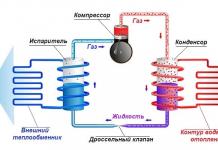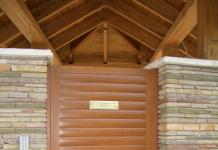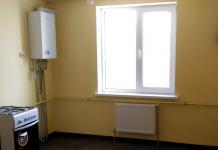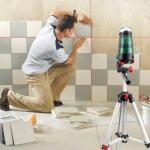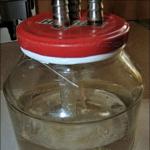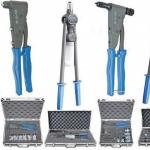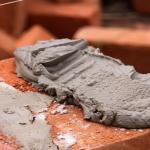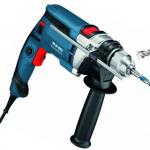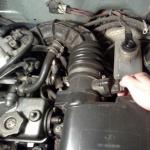The professional flooring is widely used in construction. It serves as a protective material for the walls and is a reliable roof sheathing. Every day there are different textures and colors of the material, which allows you to install a gate made of corrugated board, suitable for the design of the house.
Advantages of corrugated board
Fences are increasingly being used, in which a profile sheet acts as an upholstery. This is due to a large set of advantages, and the presence of only a few disadvantages.

Advantages:
- The surface of the material is covered with a protective film that protects it from corrosion damage. In addition, intense sunlight and temperature changes practically do not affect the strength of the material.
- Light weight and easy installation. If desired, the gate can be installed in one day, provided that the support pillars are dug in advance. During installation, you need to seriously monitor only the dimensions of the workpiece.
- Variety of colors and textures.
- Wear resistance and long service life. If the surface is treated with protective materials, the material will last more than 60 years.
- Low price.
- The ability to choose any desired width and height of the sheet.
- Ease of operation.

Flaws:
- Lack of soundproofing.
- The material is easily deformed.
- The appearance on the surface of even small damages violates the integrity of the protective surface, which leads to the appearance of rust.

The ratio of strengths and weaknesses pushes many to manufacture not only gates, but also swing gates from corrugated board.





When choosing a material, it is worth giving preference to a galvanized profiled sheet. This will eliminate the need for additional processing.

You can also choose the option with polymer protection of the painted side. This will protect the drawing from fading and washing out.

Lith marking:
- N - carrier. Durable sheets with deep stiffeners, more often used as roofing material.
- C - wall. It plays the role of a protective screen that is installed on houses or a fence.
- NS are universal. Has the strengths of both options.

Also, after the marking, numbers can be placed. They show the height of the profile. The gate does not need heavily corrugated surfaces, so models C and CH are suitable.

Of course, the absence of ribs will not favorably affect the strength of the structure, so the maximum step should not be more than 20 cm.






Making a gate from corrugated board with your own hands
Before you make a gate out of corrugated board, you need to provide it with a reliable support. For this, the existing fence supports are ideal, but if the entire structure is being built from scratch, you will have to install them yourself.

The first thing to do is to dig a hole 1.5 meters deep. A pillow of sand and gravel is poured on its bottom. The supporting pile must be made of a steel pipe with a minimum diameter of 10 cm. It is installed vertically in the hole, which is then poured with concrete. It is worth continuing work only after 7 days.

Stages of manufacturing a swing gate
From strong beams, you need to weld a reliable frame, which, with the help of fasteners and hinges, will be fixed to the support. Before you start doing this, you need to decide whether the perimeter of the gate will be surrounded by an additional load-bearing structure.

After the frame has been completely welded, you need to weld the hinges and install it in place. If the door opens freely, remove it and begin to sheathe it with corrugated board.

The gate with corrugated board elements will hang securely even on two fasteners. The handle and lock must be screwed to the outer tube, otherwise it will not be well fixed on the thin skin.

All horizontal elements must be checked with a level, and vertical ones with a pendulum. If all lines are straight and perpendicular to each other, there should be no problems during operation.


If the corrugated board will be welded to the frame, it is necessary to protect the outer side of the sheet from flying sparks. This can be done with ordinary cardboard.

On the Internet, there are many options and photos of gates from corrugated board. They differ in the complexity of installation, size and design. If desired, you can make a sliding gate that will give the impression of a modern home.

Conclusion
One of the most important advantages of corrugated board gates is the price. The material is much cheaper than wood or massive metal sheets. In addition, you can forget about regular surface care, it is enough to wash it with ordinary water if necessary.






A variety of shapes and colors allows you to select successful and unusual combinations. Anyone can independently install such a fence without special training.

Photo gates from corrugated board











































This time we will talk about the simplest way of arranging the entrance to the site. Gates made of corrugated board can be both temporary and permanent solutions. In any case, you need to be able to properly build a frame, trim and hang the gate. And we will tell you how to do it.
Installation of pillars under the gate
Imagine a gate leaf hung on a pole, like a flag with a rigid canvas. Here the usual rule of a lever applies, the fulcrum of which is located close to the surface of the earth. At the same time, the load on the “flagpole” increases in proportion to the distance from the axis, that is, the longer the leaf, the more the pole will turn out. Therefore, we will make it a rule that the underground part of the column should not be less than the above-ground part, and if the length of the leaf is more than one and a half times the height, the difference in this distance is added to the depth of penetration.
 The method of concreting the support. 1. Support - steel pipe. 2. The upper block of the foundation with the above-ground part. 3. Reinforcing cage. 4. Backfill. 5. Lower foundation block. 6. Reinforcing cage. 7. Sand cushion
The method of concreting the support. 1. Support - steel pipe. 2. The upper block of the foundation with the above-ground part. 3. Reinforcing cage. 4. Backfill. 5. Lower foundation block. 6. Reinforcing cage. 7. Sand cushion
Round steel pipes are usually used as pillars. This is not to say that this is the most reliable option, but for lightweight structures, which corrugated gates are, it is quite appropriate. If the gate is weighted, for example, by forging, care should be taken to reinforce the column with a stiffener by welding a piece of the corner from the outside, where the fence frame begins.

The easiest way is to use ready-made steel racks for the fence. As a support for the gate, it is enough to take a post one or two sizes larger
Gates spend more than 99% of their lifespan in the closed state. This means that it is not necessary to take into account the displacement of the force vector during opening, but in the plane of the gate, the poles for hanging should have maximum rigidity.
Holes for poles are drilled 5-7 diameters of the pipe used. At the lower end of the pipes and in a section of 20-25 cm immediately below the ground, you must first wind 10 mm of profile reinforcement for better adhesion to concrete. After that, you need to pour a bucket of fine gravel into the bottom of the holes and install the pipes, aligning them in the general plane of the fence, using lacing.

First, only the base of the pillar, about 40 cm high, is poured with concrete. The pipes are carefully aligned in a common plane and in height, in the above-ground part they are temporarily strengthened with wooden supports. It is necessary to take three days to solidify the concrete and ensure the complete immobility of the pillars for this period. After that, the hole is covered with rubble to a level of 35-40 cm from the surface, the backfill is carefully compacted.
The upper part of the pillars must be poured after the preliminary expansion of the pit to a square measuring 40x40 cm and the construction of formwork for the above-ground part with a height of about 5 cm. Please note that you can hang the gate only after the concrete has gained maximum strength, that is, after 3-4 weeks.
Frame for gates and wickets
The frame for the gate must meet two main requirements:
- The frame must have sufficient rigidity so that the sheathing sheets do not lead over time.
- The frame should not be unnecessarily heavy so as not to create an additional load on the hinges and poles, as well as to save material.
- The total length of the leaves should be 100 mm less than the distance between the posts: 40 mm for each canopy and 20 mm between the leaves so that the gate does not jam from heating in the sun.
Of course, to give rigidity, the frame can be slanted in this way, but we recommend adhering to a rational approach. It is important that the extra weight from the braces is concentrated as close as possible to the hinge side of the sashes.
 General scheme of swing gates. 1. Support foundation. 2. Backfilling of the support. 3. Support post. 4. Sheds. 5. Braces. 6. Sash frame. 7. Knot to reinforce the corners of the frame
General scheme of swing gates. 1. Support foundation. 2. Backfilling of the support. 3. Support post. 4. Sheds. 5. Braces. 6. Sash frame. 7. Knot to reinforce the corners of the frame
Let's start with the frame: cut out four segments from the profile pipe (two exactly along the length of the sash and two along the height). We immediately sand the blanks from rust and remove the remnants of rolling grease with a converter. We trim the edges at 45 °, performing bevels towards each other.
Lay the frame out on a flat surface. A sign of the correctness of a rectangle is the equality of the diagonals, so compare them with a tolerance of 2-3 mm, undermining the edges if necessary. When the diagonals are aligned, dot tacks at the inside corners of the frame, and then check again. Grab one point at the outer corners and check the diagonals again: the metal leads noticeably from welding, sometimes the diagonal can pull up to 10 mm. If equality is met, weld continuous seams first at the outer corners, then at the inner, and only then along the plane on both sides.

Now the frame needs to be slanted correctly. First, add one horizontal crossbar exactly in the middle of the height - it is needed to fasten the sheets. Next, connect the upper corner from the side of the canopies with this crossbar, stepping back on it 2/3 of the length of the sash.
From the lower outer corner, throw the second cut towards the first, so that the attachment point to the crossbar is 1/3 of the length of the sash from the hinged side. Finally, make two scarves with a side of 12-15 cm from sheet steel and strengthen the remaining free corners with them.

If a gate is planned in the sash, add a vertical post a meter from the side of the hinges. Filling the remaining part with braces is carried out according to the same principle. The gate is welded from a pipe of the same thickness as the rest of the frame, and then fixed inside the contour on ordinary door hinges. Inside it, you do not need to add braces, only one horizontal crossbar.
Don't forget to drill one hole in the bottom of the sash and in the crossbar for draining the water. You should not count on the tightness of the seams: water will inevitably accumulate inside the frame during rain, until the pipes at one point inflate.
Hanging, fitting, fitting
You can hang the sashes alone. To do this, it is necessary to knock down a pair of T-shaped supports from the timber, to which the gates are tightly wound with steel wire. Adjusting them in height is quite simple, you just need to knock the rack up or down with a hammer, and then slightly tighten the twist.
Install the gate in such a way that the frame has a gap of 10 to 15 cm from the level of the finished yard cover. It is not necessary to align the leaves strictly horizontally, it is more useful to reach a compromise so that the gaps on all sides are evenly distributed.

The method of attaching the hinges depends on the direction of opening. If the gate opens inward, it is recommended to weld the canopies into the end of the frame for greater stability. At the same time, the gates are connected to the post with short inserts made of sheet steel, and the suspension points are correctly closed by releasing the sheathing along the edges.
When opening the gate outward, such an arrangement will lead to the fact that the outermost sheet of the casing will be jammed. Canopies in this case are recommended to be welded to the poles, having previously fixed segments of a steel angle on them in order to shift the hanging point from the center outward and conveniently weld the canopy cylinders. The frame in this case is connected to the hinges by means of short inserts from a thick strip.
How to sheathe the gate with corrugated board
Before proceeding with the sheathing, you need to fix the vertical latch to fix the stationary sash, install locks and other fittings. Then the sash frames must be removed from the hinges, scale and rust residues removed, primed and opened twice with paint, preferably in dark tones.

It is recommended to sew sheets with the doors closed, pulling the lacing along the upper edge. First, the stationary leaf is sheathed, starting from the center of the gate. The position of the sheets is vertical, the first one is screwed flush with the frame. From the side of the loops, the extreme sheet must be cut, releasing it to the desired distance to mask the loops. Please note that when the sashes are opened outward, the hinges will be visible; rectangular cutouts must be made under them. Cut edges are recommended to be wrapped inward, including on cutouts, and then treated with anticorrosive.

The movable sash is sewn in such a way that the sheet moves onto the stationary sash to form a porch and, at the same time, lies along the wave. If the sash has an opening for the gate, the sheets must be cut flush so that the clearance is clear. At the same time, the wicket lining is put on the sash from above, below and on the side of the lock, and from the side of the hinges it is tucked onto the end of the frame frame and fastened with small self-tapping screws through pre-drilled holes.

At the bottom under the gate, the same ventilation gap should be maintained, which was provided for throughout the fence. When sewing, the sheets are laid below the frame and oriented with the cut edge up. After installation, the upper edge of the door is covered with a protective corner profile in the color of the rest of the coating, and a light galvanized mesh is imperceptibly fastened from below.
In modern construction shopping centers you can find an abundance of materials that are used to make fences and gates. Most often in this role are steel, wrought iron, wood. However, such a fairly new building material as corrugated board, which is being chosen by an increasing number of owners of summer cottages, is gradually gaining a leading position. And do-it-yourself gates from a profiled sheet are found in suburban buildings more and more often.
The corrugated board is essentially galvanized steel, expressed in sheet implementation with a polymer coating. This is a fairly new material on the market. There are several reasons for the choice of builders and owners of summer cottages:
- despite the fact that steel predominates in the composition, this material is very light, has already managed to prove itself excellently in use;
- very easy to install. We will try to testify to this in construction practice, showing how to create gates from corrugated board with our own hands. At the same time, we will try to understand its types and find the best variety.
Gates made of p-flooring have their own design features, positive and negative qualities. The positive aspects of fences made of this material include:

Since the corrugated board is made in a variety of colors, you can choose a color that will fully comply with the aesthetic needs of the consumer and harmonize with any components of the decoration in the suburban area. Varieties of gates from this building material according to the opening method are divided into:
- Opening.
- Swinging open.
- Expandable.
- For car garages.
- Swivel-rising.
For the most part, of all varieties, there are rolling and swinging gates.
Such a performance is considered traditional, and most users are accustomed to observing this particular method of performance in summer cottages. The structure has two posts, on which the gate doors made of corrugated board are placed. Due to the fact that bearing loops are applied on the racks, soft opening is obtained. The door or gate, as a rule, is located in the adjacent section of the fence, but there are cases when the door is built into one of the gate compartments.

Opening occurs by means of a manual method of action or mechanically, by means of an auto-electric drive built into the design. In most cases, the drive is used for entrances to industrial facilities and other service areas. However, in recent years, more and more often, the electric automation that controls the gate finds its admirers in the construction work of private premises.
It should be noted that due to the use of corrugated boarding in the production of gates, you can save your money on the purchase of a drive, since the gates come out easier than similar models from other materials, and an auto-closer will suit even low power.
Swinging gates activate high interest due to the availability of building materials and the ease of working with them. However, in cases where there is no place to open sections, this option will need to be rejected and you will need to think about how to make swing gates from corrugated board with your own hands.
Such gates are recognized as the most comfortable to use due to their operator characteristics. Everything is explained by the fact that when plowing, they are moved to the side, without occupying the required area of space in front. If the area does not favor the use of swing gates due to lack of free space, this type of fencing will become literally indispensable. It is fashionable to provide an additional door right inside the structure. Gates made of corrugated board with a gate will provide both the entry of equipment and the separate entry of people.

Structurally, it will be possible to achieve a very free opening for moving vehicles and parking cars, since such gates can be 10 meters long. Using opening gates in winter, you can not waste a lot of time on painstaking snow removal, since snowdrifts will not interfere with the opening of the sash, as happens when opening swinging ones.
Also, due to the design, which eliminates the guides in the clearance, you can not worry about the passage of cars of any height. It should be noted that the use of sliding gates without additional automation is very inconvenient due to the large dimensions of the door. In this regard, if you are thinking about whether you need a gate with a sliding type corrugated board, it makes sense to think over the moment of purchasing an automatic drive.

The main disadvantages that are present in the retractable type of gates made of corrugated board include: the need for systems of this type of gate to use a strong base, which increases financial costs. It is mandatory to use special components that are designed to ensure the correct functioning of the gate.
Installing these types of gates is the most difficult and, as a result, more expensive. What should you focus on when buying a profiled sheet? Mainly, it is worth familiarizing yourself with the brand and type of coverage. Such material may vary in width, configuration and cell depth. The extent to which the future gate will be solid depends on the size of the protrusion on the profiled sheet.
As already mentioned, the assembly of such gates will require considerable effort. However, everything will work out, and any installation work will be on the shoulder, if you initially understand the characteristic features of the installation and understand the technology by which retractable doors are built.
Preparatory stage: purchase of parts and creation of a drawing. The list of necessary components is necessary, because without them it is impossible to complete the gate:
- Guide rail. The size must be selected from this calculation: the opening clearance multiplied by 1.6. The width depends on the weight of the gate.
- Roller carriages (20 pieces will be enough).
- Catchers for the high and low parts of the door (2 pieces).
- The fee required to stabilize the movement of the sash at the time of opening.
- Retractable roller, which is designed to reduce noise during operation.
The above is true for sliding doors. If it is planned to perform a retractable type of fencing without a drive, then the materials listed below do not need to be purchased:
- hydraulic reducer;
- the rail is torn;
- control node;
- assembly tools;
- photocells;
- control signal lamp.
As already mentioned, it is necessary to carefully plan the work in advance, including preparing drawings. They must contain the following information:
- Gate body length.
- Counterweight scale.
- The height of future doors.
- The distance of each jumper.
First you need to place pillars in the ground that will hold the entire structure.
The columns must be made of:
- channels;
- metal pipes;
- oak beams;
- bricks or concrete using mortgages.
- An excavation is dug below the freezing level of groundwater, a bar or pipe is placed using the building level. After that, everything needs to be poured with concrete mortar and wait until it is all completely dry.
- If a foundation is required for a mobile version of the fence, then in this case a channel up to 20 cm in size and fourteen-millimeter metal bars will be required.
The first step is to make a bench. The rods must be cut to the required length and welded to the channel. Then they dig a hole in the ground of a certain shape. Where the column will be located, the recess should be one and a half meters, and between them - half a meter. To the bottom of such a pit put sandy sprinkles. At the end of the work, you need to place the pre-prepared bench in the dug recess and level it. Then the foundation is poured and left to dry for 6-7 days.
To do this, we need pipes of certain sizes. It will be necessary to prepare in advance segments of 60 by 30 and 40 by 20 mm. Next, we turn to the drawing. According to him, we cut the pipes in accordance with the specified dimensions. To do this, you can use the grinder. Then they are cleaned, freed from fat and dyed.

In order for the sliding gates to look their best, the pipes are covered with primer before you start painting. First, the frame that will stand outside is welded into one piece, then the inner frame is welded. Since the sheet of corrugated board will be attached to the latter, it is worthwhile to calculate the distance between the borders in advance.
The cladding process
We have come to the final stage of creating homemade sliding fences. To complete the work, perform the following steps:
- first we install a frame on a frozen foundation;
- we fix the rollers on the channel (it is desirable to place them as far as possible from one another, however, taking into account the fact that the outer rollers should not touch the plug when closing;
- after that, the rollers are installed in the lower part of the fence and are selected using a liquid level;
- when everything is leveled, the planes of the carts are scalded for fixing;
- the same is done with the ends and traps;
- we control that the extreme rollers coincide with the trap both at the bottom and with the vertical axis of the frame.
In fact, everything is ready. It remains only to sheathe them with a professional sheet. Here it is desirable to use fasteners as measuredly as possible. It should be noted that the material we have chosen will be optimally fastened with self-tapping screws or rivets. The last details will look beautiful and stylish.
However, when you want to remove the profiled sheet in order, for example, to replace or repair it with something, or fix it, it will be almost impossible without damaging the entire structure. Also, fasteners are best done only in profile recesses, while the distance between the rivets should not be too spacious. Otherwise, the material can be quickly torn off by strong winds. Practice shows that the best option is to use 6 self-tapping screws per 1 m squared.

Finally, I would like to note that if the size of the existing site makes it possible to put swing fences on it, then this possibility should not be neglected. Firstly, it is reliable, secondly, it is convenient, thirdly, it saves space well, and fourthly, all the work, from the foundation to the components, will ultimately cost much less than any other options. If for some reason you can only install a rollback type, then it is worth remembering that here it will be necessary to spend effort and money on automation.
The standard version of the fence in total with the gate and the gate at the border of the site in front of a small country house is easiest to build from a profiled pipe and corrugated board. A professional welder or locksmith will do this job best of all, but for a person who has at least a little practical experience in plumbing and welding, the manufacture of gates and gates from corrugated board can be done with his own hands and even without outside help.
Which type of gate with a wicket to choose
There are not so many schemes for constructing such a structure as a gate made of corrugated board with your own hands, as it might seem at first glance. Of the most possible options in the practice of private housing construction, three gate schemes with a wicket are used, tested by time and many years of use:
- Attached design of the gate made of corrugated board. To two pillars with hinged doors made of corrugated board, a third pillar is added - a support on which the frame structure of the gate is hung;
- A more difficult to manufacture option with a built-in gate in the gate leaf. Most often it is used in situations where there is simply not enough space for an attached gate made of corrugated board;
- A very unusual version of a folding gate made of corrugated board with a gate. Such a scheme can be applied in cases where there is not enough space in the passage even to open the frame gate leaves.
For your information! The most beautiful gates will be made of blue or dark red corrugated board, mounted on red brick pillars.
Such a design will cost more due to the purchase of an additional couple of hundred facing bricks and the payment for the services of a bricklayer for laying out three columnar supports, but the appearance of such a gate with a corrugated board gate cannot be compared with other options, even taking into account the use of decorative elements. Such gates and gates from corrugated board photos are much more attractive and beautiful.

In addition to a beautiful appearance, such brick pillars are able to take on the lion's share of the load, especially during periods of strong winds or intense slanting rains.
What materials to make a gate with a wicket
In 90 out of 100 cases, the structure of the gate made of corrugated board is made of a standard profiled pipe of square and rectangular section. For vertical supports, a steel tubular profile of square section 80x80 mm is used, for the manufacture of the frame of the wings and internal lintels, depending on the span of the swing halves, they take a profile of 60x20 mm, for gates - a lighter rectangular tube 40x20 mm.
As a facing material, corrugated board, wall or universal, grades “NS”, “N” or “C”, with a material thickness of 0.5 mm, is used. To enhance the decorative qualities of facing the gates and gates at your own home, when sheathing the frame of the wings, a corrugated board with a colored polymer coating is installed; galvanized material is better suited for a summer cottage or a country house.
In addition to corrugated board and profiled pipes, you will need fasteners - self-tapping screws or rivet "caps", garage hinges and bolts, sash stoppers. If the material for manufacturing is purchased from a used category, a brush head with bronze bristles and a phosphate rust converter will be required.

In addition to the material, you will need a welding inverter or a carbon dioxide semi-automatic machine, a grinder, a tape measure and a steel locksmith's ruler, a screwdriver with a set of nozzles for a self-tapping screw or a head for mounting and crimping rivets.
We make do-it-yourself gates from corrugated board with a gate
A common issue, equally important for any gate schemes, is the arrangement of the foundation for vertical supports. Most often, the installation of gates and gates from corrugated board is limited to drilling wells with the installation and concreting of steel tubular profiles according to pre-made markings and alignment. For gates and gates made of corrugated board up to 2.5 m wide, such binding of the posts to the ground is quite enough to ensure stability. Experts recommend reinforcing lengthy structures with a strip foundation or brick laying.

If the pipes are overlaid with brickwork, then the total rigidity of the base and vertical supports will be sufficient to install heavier or higher gates. Often, such a scheme is resorted to as a reserve for the future, when simple gates and a gate made of corrugated board will be replaced with heavier and more elegant forged doors.

It is impossible to go too far in the matter of strengthening the foundation, although, in fact, this is an additional waste of money and time. More critical is the situation when, after assembling the gate and wicket, even with a lining of light corrugated board, the rigidity and stability of the base is not enough. In this case, you have to make a “deck” - building up a concrete strip foundation with the finished gate. For this:
- A trench 30 cm deep and wide breaks out between the pillars of the supports;
- A layer of gravel and sand is poured to the bottom of the trench;
- Four or six bars of reinforcement are laid and welded between steel pillars, after which the lintel is poured with high-quality concrete.
For a period of up to a week, while the material is hardening, the sashes must be unloaded with a jack or any other support.
Advice! Instead of a reinforced concrete lintel, it is possible to lay a steel T-beam with a width of 150-200 mm.
Manufacture of the frame of the gate leaves
The manufacture of the sash frame is most often carried out by welding pre-cut blanks laid out on a prepared flat area covered with steel sheet or paving slabs.
The most successful gate project with an attached gate and corner cladding can be called the option shown in the photo.
A distinctive feature of this project of corrugated boarding doors is the rather competent use of unloading diagonal crossbars. Their use allows you to unload the lower horizontal bar of the frame by 60%. In addition, along the length of the diagonal, it is quite easy to control the right angle and symmetry of future wings.

The most difficult stage is the alignment of individual segments of the profile in the form of a regular rectangle. Due to the large dimensions of the sides - 2500x1800 mm, it is very difficult to adjust the position of the sections of the profiled pipe so as to obtain a perfectly accurate right angle. Therefore, the corners in the frame of the future door leaf are measured with a locksmith or joiner's corner, and the size of the diagonal is controlled.
After leveling the position, the frame of the future two gates with the gate is welded with dots, struts and two central posts are installed, as shown in the photo. In this form, the frame is transferred to the installed gate posts and hung out on a stand in the opening between the supports. After marking the position of the garage sheds, the upper parts are welded to the frame, the lower parts to the posts. Without changing the position of the frame, the completed welding points are welded with full seams. Along the perimeter, on the inside of the frame profiles, a 40x20 pipe is fixed by welding or self-tapping screws, on which sheets of corrugated board will be attached in the future. Next, the gate frame is cut into two equal leaves, and you can proceed to facing with sheets of corrugated board.

The wicket frame is made according to a similar scheme, but with some simplification. To get the most accurate shape of the rectangle of the doors, the cut sections of the profile are assembled on a wooden jig knocked down from the boards. Sections of the profiled pipe are attached to the sides of the conductor and welded into a rectangular frame. In a similar way, the location of canopies and diagonal struts is determined. Both wings and the wicket frame are painted with a primer and alkyd enamel before laying corrugated sheets.
We sew corrugated board on the gate and gate
Laying corrugated board on the door frame begins with marking the cutting of sheets of material to the required size. It is better to cut corrugated board with scissors for metal, but at the same time the stepped profile of the material is deformed, which has to be constantly leveled.

When calculating the required number of sheets of corrugated board, it is necessary to take into account the consumption for overlapping in one or more waves, and choose such a size that there are depressions rather than ridges on the edges of the frame. Therefore, the smaller and narrower the corrugated board wave, the easier it is to fix the material, especially on a narrow gate frame.
Fastening is carried out through one wave in the depressions of the corrugated board. The most common is fastening with roofing screws or rivets. Rivets are more expensive, but the quality of fasteners is much higher.
Alternative version of the gate with a wicket
If there is not enough living space at the entrance for a full-fledged arrangement of swing gates with an attached gate, the latter can be made by simply transferring the frame to the leaf plane.
In this case, it will be necessary to change the scheme of strengthening the gate leaf frame with transverse horizontal struts.

Depending on how it is more convenient to use the wicket door, the doorway can be shifted to the post or to the center of the gate. After marking, the wicket frame is attached to the sash frame with side crossbars. Hinges for wicket doors, in contrast to fastening the wings to poles, are welded on the inside of the gate structure. After welding the frames of the gate and the gate, it remains to sew up the plane with sheets of corrugated board.
So that the front surface of the gate does not stand out against the background of the gate leaf, it is necessary to select or cut out a piece of corrugated board that matches the shape and line of the profile with the main cladding. It is recommended to fasten such a corrugated board initially with the help of hidden bolted connections, and after final alignment, fix it with self-tapping screws or rivets.
If there is not enough space for the installation of standard swing structures with a gate, as an option, you can use a sectional door system.

The design of the gate does not differ from the attached version, while the gate leaf is made according to a folding scheme of three panels connected by door canopies. In the folded state, such gates practically do not protrude beyond the dimensions of the fence of the site.
Conclusion
Of all the possible options for gates with a wicket, a frame structure made of corrugated board is the cheapest and easiest to manufacture. At the same time, the average service life of the cladding and frame material is not inferior to expensive forged and panel structures. To give the corrugated surface a more respectable look, you can use inexpensive overhead imitations of forged patterns and decor. Even in this case, corrugated board will cost less than real forging and casting.
Increasingly, on personal and suburban areas you can see gates made of metal profiles of a wide variety of shapes and sizes. This material has many advantages: strength, reliability, presentable appearance, long service life and low cost. How to make a gate from corrugated board yourself quickly and at no extra cost - read below.

An example of a gate made of corrugated board - a photo of an option with installation on brick pillars
How to choose the size of the gate from corrugated board?
There are no strict mandatory norms and restrictions regarding the size of gates. However, when choosing them, consider the following:
- The optimal width of a gate made of corrugated board is 1.0 m. This width of the opening allows you to easily bring furniture or other overall items onto the site. Moreover, if it is larger, then this can lead to rapid wear of the hinges or skew of the gate leaf.
- The height of the gate should not exceed 2.0 meters. If the fence around the site has a large height, then such a gate from a profiled sheet will not look very good. In this case, in the opening between the supporting pillars above it, it is better to install additional crossbars with an insert from a metal profile. This will allow not to overweight the canvas of the gate itself.
Of these rules, of course, there are exceptions. For example, if your height or the height of someone from your family is above 2.0 meters, then making a gate from corrugated board of great height will be simply necessary. However, at the same time, you should not forget about using special hinges and strengthening the frame with additional crossbars.
Installation of support poles
The first and one of the most time-consuming stages of work is the installation of support pillars, on which the metal profile gate will be held, with your own hands. This is not difficult to do, but it will take a lot of time, especially when it comes to brickwork.
There are two options for a fence device from a profiled sheet. The first and most simple is the option of attaching the fence to metal pipe poles dug into the ground. In the second version, a fence with a gate and a gate made of corrugated board is attached to pillars made of brick or stone.
Use of metal support poles
The use of a profiled sheet for the manufacture of an entrance group has become so widespread, since it is very simple and inexpensive to make a gate and a gate from corrugated board. Therefore, in the vast majority of cases, metal pipes are used as supports. Installing them is much easier, cheaper and faster than brick ones.
For the supporting pillars of the gate is best suited profile pipe 80x80 mm with a wall thickness of 3-4 mm. For their installation, holes are dug in the ground, with a size of at least 300x300 mm and a depth of at least 1.0 m.
The depth of the pits depends on the type of soil at the place of installation of the pillars. If the soil is rocky, then 70 cm will be enough. But if the soil is clayey, the depth of the pits should be no less than the depth of soil freezing. In most regions of the middle lane, this is 1.2 m.
be careful
Installing a gate made of corrugated board on insufficiently deepened pillars in heaving soil leads to serious deformations of the frame and canvas, the correction of which is often impossible.
Support pillars made of brick or stone
In this case, the dimensions of the foundation must be greater than the cross section of the supporting column. Typically, such pillars are made in 1.5 bricks, that is, 390x390 mm. Therefore, the foundation must be at least 500x500 mm in size. Since it is much more difficult to make such posts for the gate from corrugated board yourself, this option is chosen less often.
By itself, the brickwork does not withstand the bending load well, therefore, to give the pillar additional strength, a metal pipe is installed in the pit before the foundation is poured with concrete. Around it, masonry is made of brick or stone. Metal mortgages are welded to the same pipe, which are brought out of the masonry. On them, subsequently, the installation of gates and gates from corrugated board will be carried out.

Classic metal profile gate - photo of mounting on poles using an external frame and mortgages
The upper part of the metal support posts must be closed with plugs to prevent moisture from entering the post. If it is planned to install lamps near the gate, then before concreting the pillars in them, it is necessary to tighten the wire in the corrugated pipe.
Preparing parts for the frame
While the concrete mixture in the foundations of the supporting pillars is gaining the necessary strength, you can start assembling the gate itself. Before you make a gate from corrugated board with your own hands, you need to make a frame for it.
For the frame take profile pipe 40x40 mm or 60x30 mm. A light small gate can also be made from a 40x20 pipe, but then, in order to give the frame the necessary rigidity, the pipe must be placed with the narrow side to the corrugated sheet sheathing.
At the bottom of the pit, a layer of rubble is poured and carefully compacted. Then, strictly vertically, with the help of a level, pillars are installed in it, and the pit is filled with a concrete mixture. It is possible to hang gates and gates from a metal profile on concreted pipes no earlier than after 5-6 days. This time is necessary for the concrete to gain at least 20-30% of its strength.
In order to avoid mistakes in the preparation of parts, before cutting the pipe, it is better to first draw a sketch or draw a gate from corrugated board with all the necessary dimensions. An example of such a drawing is shown below.

Detailed drawing of a gate from a metal profile
The prepared pipe is cleaned of rust with a metal brush and cut into blanks of the required length. For assembly, the edges of the blanks are cut at an angle of 45 °.
In addition, in order to make a gate from corrugated board, it is necessary to cut out one or two crossbars, depending on its height, which should fit closely between the large sides of the frame. This will make the structure more rigid and subsequently facilitate the installation of the lock.
Gate frame welding
The workpieces are connected to each other by welding. So that the frame does not deform at the same time, before making a gate from a profiled sheet, the workpieces must be fixed from a profile pipe in homemade jig.
It is very easy to make it:
- An OSB sheet with a thickness of at least 10 mm or a sheet of thick plywood is taken.
- A canvas is cut out of it, the width and height of which must be at least 50 mm larger than the planned dimensions of the gate.
- Clamps are being prepared that will hold the frame elements, pressing the metal profiles to the surface of the sheet. Clamps should be twice as many as welds.
Before welding a gate from corrugated board, all corners are carefully checked and the diagonals of the frame are measured. One or two crossbars are installed between the upper and lower lintels of the wicket frame. Then clamps are installed, which should be at a short distance from the welding site.

Scheme of how to weld a gate from a corrugated board using a jig from an OSB board and clamps
After fixing all the elements of the frame on the conductor, it is necessary to check the angles and parallelism of the opposite sides of the frame again. Then you can start welding. At the same time, the clamps cannot be removed until the seams have completely cooled down - otherwise the temperature stresses in the metal can deform and even destroy the metal. After welding is completed, all joints are cleaned.
Thanks to this welding technology, a gate from a profiled sheet with your own hands can be made even by a complete beginner. In this case, even if you have some welding experience, I do not recommend neglecting the fixation of the workpiece. Remember that making a new frame after accidental damage to the old one will take more time and will cost more than making a simple jig.

Drawing for swing metal gates with corrugated boarding gate (click to enlarge)
In small summer cottages, gates with a gate made of corrugated board are often installed. All operations for assembling the wicket frame built into the door leaf are carried out in the same way as described above. The design of the gate is subject to change, in which an opening for installation must be provided. In addition, the need to build a gate imposes certain restrictions on its height.
Installation of fittings on metal profile gates
After the gate frame is assembled, but before the frame is sewn with a metal profile, hinges and plates are welded to the gate to install the lock and handle, if necessary.
Hinges for gates from corrugated board are installed towards each other and grab with welds 1-2 cm long. The loops are placed so that the canvas cannot be removed after the final installation. With this installation, the gate can only be cut off with a grinder. Loops are fastened at a distance of 25-30 cm from the upper and lower edges of the canvas.

Installation of hinges on a gate from a professional sheet
When choosing a lock for a gate made of corrugated board, it is necessary to pay attention to the conditions of its operation specified by the manufacturer in the passport. The lock must be designed for outdoor installation. When choosing a lock core, preference should be given to those that open from the inside without a key. This will save you from problems if the water freezes in the castle in winter.
When opening the canvas inside, the lock can be both mortise and overhead. If the gate opens outward, only a mortise lock is placed on it. The lock and handle for the corrugated gate are usually installed at a height of approximately 90 cm.
Of the mortise locks, the most convenient are special narrow profile locks designed for installation in profile pipes. The very principle of their installation partially protects them from moisture and dust, which increases their service life.

Narrow profile gate lock made of corrugated board
Before you embed the lock into the corrugated board gate, you need to mark the place of its installation: a rectangular slot for the body and a circle for the core. In addition, it is better to immediately outline the attachment points for the handle. Next, the installation process is quite simple:
- Using a grinder, cuts are made along the long sides.
- Holes are drilled along the short sides with a drill as close as possible to each other. It is necessary to drill not along the marking strip itself, but a little inside the rectangle.
- To install a mortise lock in a corrugated gate to the desired shape, the hole is brought with a file.
- Round holes for the core are cut with a metal burr. In case of its absence, drilling along the contour and finishing with a file can also be used.
- Drill holes for mounting screws.
- The place around the castle is cleaned of rust, primed and painted.
- A lock is being installed on a gate made of corrugated board, but without overlays - they are mounted after the frame has been sewn up.
This completes the installation of the lock in the frame. However, since putting a lock on a corrugated gate is only half the battle, the work does not end there. It is necessary to mount the counterpart in the support column. This stage is carried out after mounting the gate on the poles.

A good example of how to insert a lock into a corrugated gate (click to enlarge)
Additionally, a lock or a latch can be installed on the gate made of corrugated board. Such solutions make sense both from the point of view of increasing security and for convenience - especially if the gate is often used. In this case, it is easier to close it with a latch than to fiddle with the lock every time. You can also immediately purchase a lock with a latch, and do not install it separately.
How to install a gate from corrugated board on support poles?
After several days have passed, the concrete mixture in the foundations of the supporting pillars has gained some of its strength, and the assembly of the frame is completed, you can install the wicket from corrugated board.
To do this, a wooden block is placed under the frame. With the help of a level, the gate is set strictly vertically and the attachment points of the second halves of the loops are marked on the support post. At the same time, it must be remembered that for normal opening in winter, the canvas must be 100 mm higher than the surface of the track. Especially if you are installing a gate to the cottage from corrugated board, where snow is rarely cleaned in winter.
Having marked the installation sites of the loops, they are temporarily attached to the supporting pillars using electric welding. After checking the opening and closing of the gate, the hinges are scalded with a continuous seam.
Consider
Do-it-yourself installation of a gate from corrugated board requires care and repeated rechecking, since without a "fresh look" from the outside it is easy to make a mistake.
If the gate is installed correctly, it should not spontaneously open or close. So that it does not open in both directions, a limiter is welded onto the support opposite to the hinges.
When welding is completed, all seams are cleaned with an angle grinder, and rust is removed from the frame and primed. Then they are painted twice with paint for metal for outdoor use. The main part of the lock installed in the frame must be covered with a film or construction tape.

Gate frame made of metal profile mounted on poles
This is the penultimate stage before sewing, since it is also necessary to install a lock on a corrugated board gate in a support post. To do this, the crossbar is smeared with toothpaste and the lock is closed. After that, the place where the locking device should go will be marked on the pole.
If the lock is simple and there is no receiving block, then you just need to drill a hole of the desired shape and finish it with a file. If there is a receiving block, then you must first mark its location based on the place where the crossbar enters, after which, again, drill a hole of the desired shape. Then holes for fasteners are drilled, and the mate is installed.
Sewing a gate from a professional sheet
After the paint has dried, the gate leaf is sewn up with a profiled sheet. As a rule, wall corrugated board S-20 or S-21 with a thickness of 0.5-0.6 mm is used for this. The use of a sheet with a lower wave height is not recommended.
To fasten the profiled sheet, roofing screws are used, less often - special rivets. Sometimes bolted connections are used for this, but this is not recommended, since in this case the necessary corrosion protection for the web is not provided at the point where the bolt passes through the profiled sheet. Sheets are fastened through each wave horizontally and into each transverse beam - vertically.

The gate sewn up by a professional flooring with the parties, the closed corners
If desired, all sides of the corrugated board gate are closed with special square strips in the color of the corrugated board. This gives it a finished look and, in addition, is an additional protection for the frame from moisture.
After sewing up the canvas, pads are installed on the lock, as well as a handle on the gate made of corrugated board.
Design of a gate from a professional flooring
After the frame is ready, it's time to think about the design. Despite the relative simplicity of the design, there can be a lot of design options, including those using decorative elements.
The simplest corrugated gate is a rectangular frame made of a profiled or round steel pipe, on which a metal profiled sheet is attached. Such a gate for a fence made of corrugated board is perfect - it will fit especially well into the usual blind fencing of a summer cottage or personal plot. A similar solution also looks good with a fence made of brick or stone, including when using pillars made of these materials as supports.
A gate made of corrugated board with forging will look even more beautiful. In this case, the profiled sheet will serve as a kind of background for decorative forged parts. In addition, if forged elements cover the entire opening, they strengthen the frame of the gate and make it more resistant to burglary.
Do-it-yourself forged gate from corrugated board can be made without any problems. Now ready-made decorative forged parts can be bought at almost any building materials store. The main thing is not to overdo it with forged elements, so that the gate leaf does not look like a colorful and overloaded decor.
To begin with, it is better to draw a sketch of the design of the gate. The parts purchased in accordance with the sketch are laid out on the canvas and welded to the frame, starting with the largest and ending with the smallest. However, such gates made of corrugated board with forging elements look much worse than the products of real specialists.

Forged corrugated gate - a photo of some forged elements made on production lines, as well as a simple sketch that can be realized with them.
Firstly, professional artistic forging allows you to make very elegant and thin elements that cannot be produced industrially. Secondly, the range of ready-made elements is very limited. And thirdly, a forged gate with corrugated board, made by a professional, can reflect any idea and is stylistically integral, unlike composite products.
Finally, the gate can be either a separate object or part of the gate. So, swing gates with a gate from a professional flooring are often used. Such a decision is justified if for some reason you are very limited in the size of the entrance group - for example, you are changing the old gate and want to install new ones on the same support pillars.
When making the gate yourself
If all the work on installing and assembling the gate was done by hand, you will have to pay only for the materials that were needed for this. Usually the final cost is up to 2000-2500 rubles.
But the gate can not be made by yourself. You can buy metal profile gates in the construction departments of most supermarkets. Ready-made gates from corrugated board can also be purchased at specialized companies involved in the manufacture of metal structures. There you can order the manufacture of such a product according to your own sketch, while receiving a free technical consultation. When such a gate made of corrugated board is installed, its price will be from 4,500 rubles, excluding the cost of constipation and hinges.
If for some reason it was also necessary to attract specialists to install a metal profile gate, the price of such work in different regions of the Russian Federation will be from 2100 to 2500 rubles. And this is without the cost of installing a lock.
